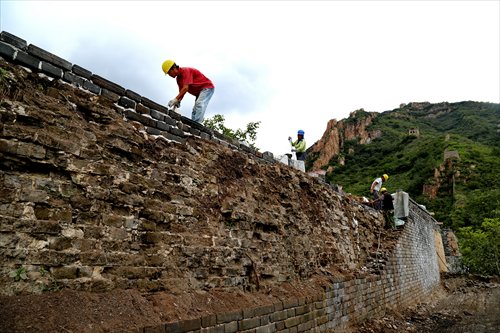
Workers repair a section of the Great Wall in Qinhuangdao, North China's Hebei Province on September 7. (Photo/Xinhua)
Cultural heritage experts have warned that local governments' attempts at restoring the Great Wall actually end up damaging the iconic landmark, due to their lack of historical knowledge and money.
The bureau of cultural heritage in Suizhong county, Northeast China's Liaoning Province suspended its project to "enclose" the Great Wall, after media reports sparked controversy, Yang Shitao, deputy head of the Liaoning provincial department of cultural heritage body told the Global Times on Monday.
Pictures circulating online showed miles of the Xiaohekou section of the Great Wall in Liaoning covered with smooth concrete, with angry netizens calling it "sacrilege" rather than protection.
An inspection team formed by the State Administration of Cultural Heritage (SACH) said at a press conference that local authorities used concrete for the restoration of the heritage site, paving over a 780-meter-long section of the Xiaohekou Great Wall, the Beijing Times reported on September 27.
Song Xinchao, deputy head of the SACH, said that they will punish institutions and individuals responsible for the incident, according to the report.
Yang told the Global Times that currently they are waiting for an official SACH document, and then they will follow the SACH's instructions to rebuild the wall.
SACH has ordered the Liaoning authorities to organize a pool of experts to solve problems in the restoration, while suggesting the 15 provinces alongside the Great Wall launch projects to address problems associated with the preservation of the Wall.
Poverty-stricken
The Great Wall was built using bricks, so only bricks can be used for restoration. However many local governments paved the brick-built Great Wall with concrete or other materials, therefore damaging it, He Xinyu, a researcher specializing in the protection of the Great Wall at the Ningxia Museum, told the Global Times.
"The initial intention was to make it more suitable for tourists to walk on," an employee from the bureau of cultural heritage in Suizhong, told the Global Times previously.
A lack of funding is another obstacle preventing some governments from properly restoring the Great Wall, Cheng Dalin, an expert on the Great Wall research committee with the Chinese Association of Cultural Relics, told the Global Times.
Cheng said that some 10,000 yuan ($1,493) is required to fix one meter of Great Wall on average. "The cost includes investigation, feasible plans from professional construction team, and specific engineering techniques, which are too expensive for governments in relatively poor area to afford.
The Beijing Municipal Administration of Cultural Heritage has invested 367 million yuan since 2000 to restore the Great Wall. But restoration work on only 45 kilometers of the Great Wall has been completed, China Central Television reported.
Of the 404 counties the Great Wall passes through, 50 percent are poverty-stricken, reported Southern Weekly.
Climbing catastrophe
Besides local governments' "destructive restoration" of the Great Wall, it also faces threats from nature and ordinary people, said Cheng.
According to 2016 SACH statistics, about 30 percent of the 6,200-kilometer-long section of wall built in the Ming Dynasty (1368-1644), which stretches over 21,000 kilometers from Northwest China's Gansu Province to North China's Hebei Province, has disappeared, and less than 10 percent of the section is considered well-preserved.
Tourists climbing and camping on the fragile Great Wall have damaged it, said Cheng.
In 2003, Beijing issued regulations to protect the Great Wall which stipulate that anyone who climbs the wall will be fined up to 500 yuan, according to the Xinhua News Agency.
Despite the regulations, some 200,000 to 300,000 people climbed one stretch of Great Wall located in Beijing's Huairou district every year, said Xinhua.
Also, according to the China Great Wall Society, theft of bricks by villagers as well as farming activities near the wall, have damaged the landmark.
Cheng also noted that threats from nature, such as earthquakes, acid rain, wind and other natural elements have left the wall with many decaying and crumbling bricks.
He suggested that due to the high cost of maintaining and restoring the Great Wall, governments can simply concentrate on stretches,"which are preserved in good condition and have historic value," said He.
Moreover, Chang noted that preserving and restoring the Great Wall require the whole society's participation. "It is an urgent task to raise people's awareness about the protection of cultural relics," said Chang.


















































